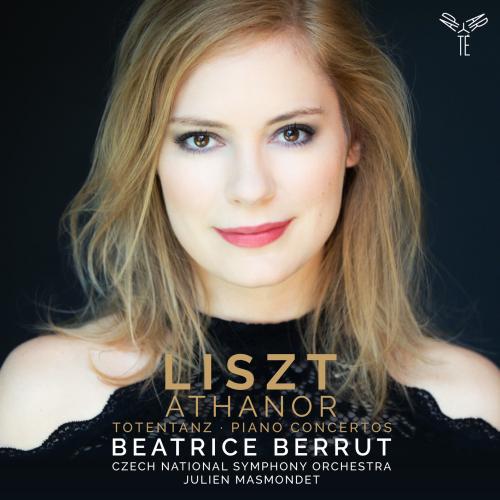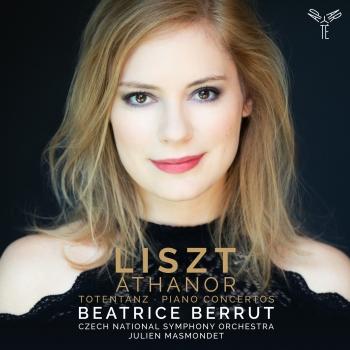
Liszt: "Athanor", Totentanz & Piano Concertos Beatrice Berrut, Czech National Symphony Orchestra & Julien Masmondet
Album info
Album-Release:
2018
HRA-Release:
27.04.2018
Label: Aparté
Genre: Classical
Subgenre: Concertos
Artist: Beatrice Berrut, Czech National Symphony Orchestra & Julien Masmondet
Composer: Franz Liszt (1811-1886)
Album including Album cover Booklet (PDF)
- Franz Liszt (1811 - 1886): Totentanz:
- 1 Totentanz. Paraphrase on "Dies Irae" for Piano and Orchestra, S. 126 15:52
- Piano Concerto No. 1 in E-Flat Major, S. 124:
- 2 Piano Concerto No. 1 in E-Flat Major, S. 124: I. Allegro maestoso 05:34
- 3 Piano Concerto No. 1 in E-Flat Major, S. 124: II. Quasi adagio 04:46
- 4 Piano Concerto No. 1 in E-Flat Major, S. 124: III. Allegretto vivace - Allegro animato 04:13
- 5 Piano Concerto No. 1 in E-Flat Major, S. 124: IV. Allegro marziale animato 04:08
- Piano Concerto No. 2 in A Major, S. 125:
- 6 Piano Concerto No. 2 in A Major, S. 125: I. Adagio sostenuto assai - Allegro agitato assai - Un poco più mosso - Tempo del andante 07:11
- 7 Piano Concerto No. 2 in A Major, S. 125: II. Allegro moderato 05:18
- 8 Piano Concerto No. 2 in A Major, S. 125: III. Allegro deciso - Marziale un poco meno allegro - Un poco meno mosso 07:05
- 9 Piano Concerto No. 2 in A Major, S. 125: IV. Allegro animato 01:46
Info for Liszt: "Athanor", Totentanz & Piano Concertos
Athanor. A mysterious name to designate, in alchemy, the long-combustion furnace that produces the philosopher’s stone. This matrix, which symbolises the quest of one who seeks to the Absolute, is a metaphor of Liszt’s approach.
With the patience of the alchemist who pursues the perfection of the material, the virtuoso composer and pianist has long matured the genesis of his two Piano Concertos and of the Totentanz: in fact, more than 20 years separate the first sketches of their publication.
These three major works are each crossed by a powerfull and captivating leading theme, and driven by a logic of transformation: the Totentanz uses the theme and variations form while the concertos are unifyed by a unique theme that nourishes the whole musical flow through its metamorphoses.
Pianist Beatrice Berrut, who was already venturing on the Lisztian paths in her previous record, testifies here to the infinite invention of the composer: she performs the first Concerto with its last variants noted by Liszt himself on the copy of his pupil Hans von Bülow.
Beatrice Berrut, piano
Czech National Symphony Orchestra
Julien Masmondet, conductor
Beatrice Berrut
born in the Swiss Alps in the canton of Valais, spends most of her childhood with her sister conquering the hills and mountains of her home valley. Barely two years old she learns how to ski and since then her addiction to the white powdery slopes has remained unabated. The inspiration found in the marvellous landscape, the stoic Alpine giants carved ancient rock, and the fascination by nature itself accompany her to this day on her musical journeys.
Thanks to her mother, Beatrice soon encounters the enchanting sound of the piano as there isn’t a night that the two sisters are not lulled to sleep by the “Kinderszenen” (Scenes of Childhood) by Schumann or “Lieder ohne Worte” (Songs without Words) by Mendelssohn.
Completely captured by the beautiful and brilliant harmonies of this big black wooden instrument, Beatrice finally decides to take her first piano lesson at the age of eight. Each day, she eagerly practices with great curiosity and devotion, since she is discovering a new world full of endless imagination and sound that is ready to be explored. A few years later, Beatrice is utterly absorbed by the sound waves of the piano. Among numerous albums collected by her parents, Beatrice finds a very particular one: She listens to the second Piano Concerto by Johannes Brahms for the very first time. It feels like an existential shock, the world as she knew it crumbled and a door to infinity opened. Sleepless nights ensue, where Beatrice virtually conducts Brahms concerto, gazing at the ceiling from her bed. Suddenly, everything makes sense: it is her mission to serve this music coming from another world. She will be a pianist.
From that moment of clarity, things follow a natural order. As a teenager, in-between long hours of hard work, Beatrice wanders along the shores of Lake Geneva, imagining composers and poets of the past finding their inspiration in this natural reservoir of beauty, just like her. Liszt, who visited Switzerland many times and fell in love with the country, becomes an important part of her life. The Vallée d’Obermann that inspired him, is where Beatrice grew up, and in his music she recognises her own quest for meaning in her mountain wanderings. ...
Booklet for Liszt: "Athanor", Totentanz & Piano Concertos










